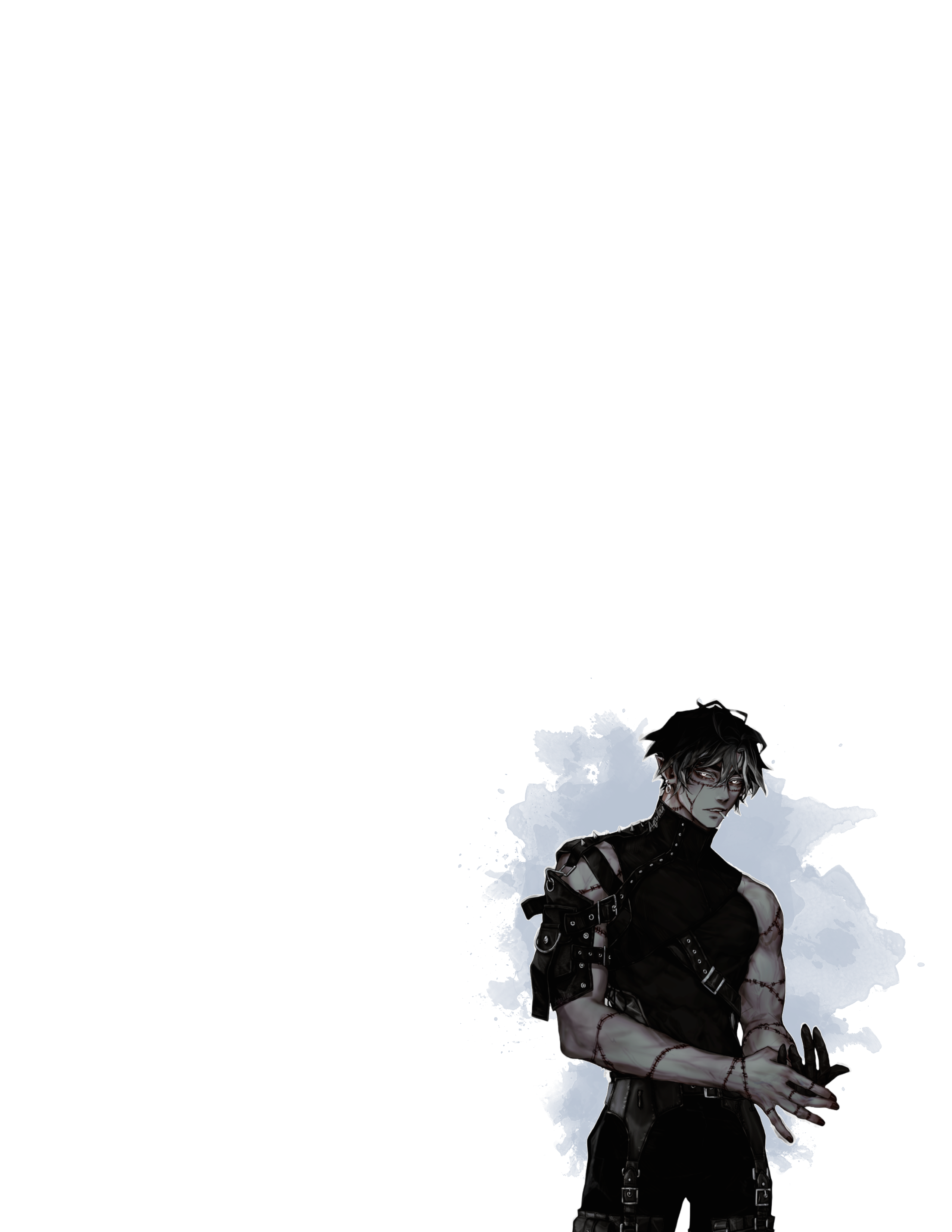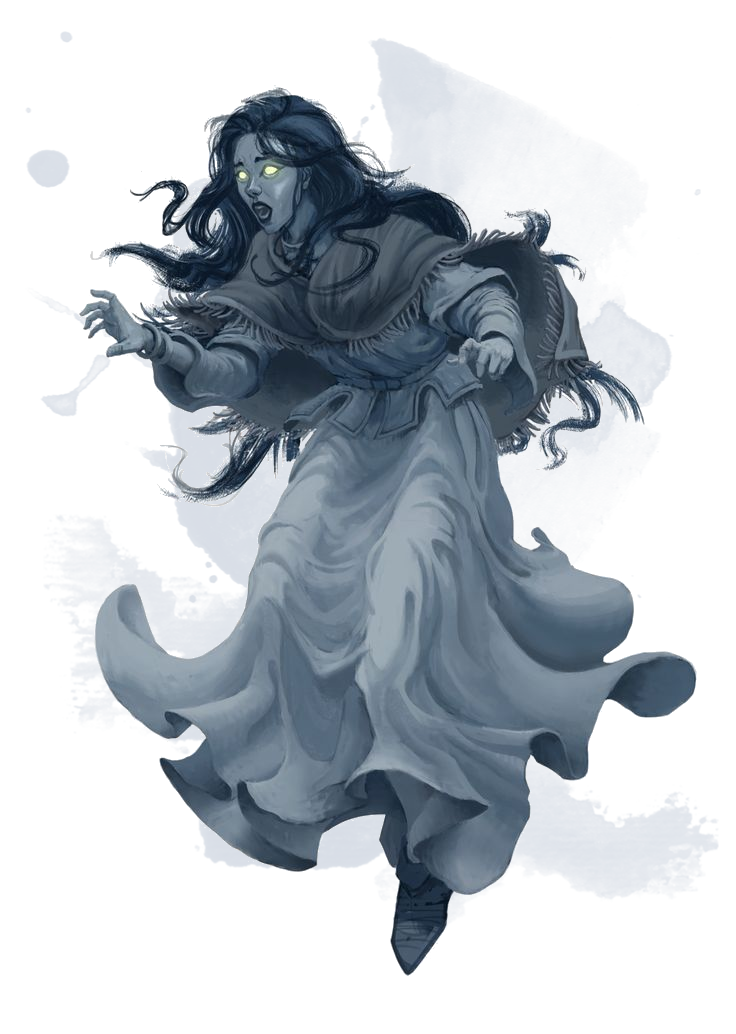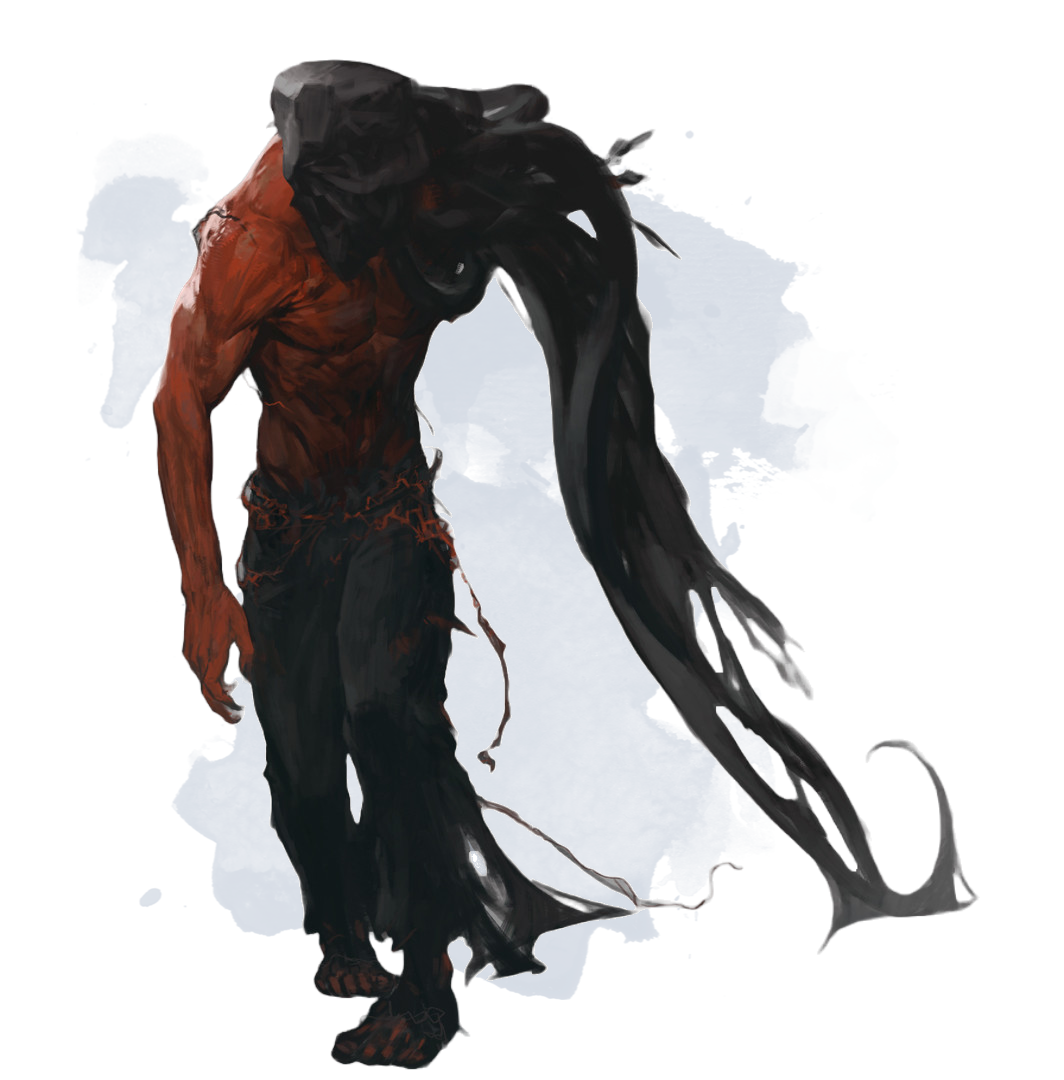

Chapter 1: Races
The Undying Collection introduces a new lineage option and three new races you can use in your campaign, alongside the races presented in the Player's Handbook and other official sourcebooks. These new races are:
Reanimated. Constructs that have been stitched together using body parts.
Boggart. A race of sentient Plant creatures that reside in the murky swamps.
Phantom. An Undead spirit that has roamed the Material Plane for centuries, teetering between here and the afterlife.
Symbiote. An Aberration whose unassuming appearance belies a deadly, powerful weapon.
Creating Your Character
At 1st level, you choose the race of your character from one of the official D&D sources or from a race in this collection. When you select a race, follow these rules during character creation.
Ability Score Increase
When determining your character's ability scores, unless stated otherwise, increase one score by 2 and increase a different score by 1, or increase three different scores by 1. Follow this rule regardless of the method you use to determine the scores, such as rolling or point buy. You can't raise any of your scores above 20.
Languages
Your character can speak, read, and write Common and one other language that you and your DM agree is appropriate for the character.
Creature Type
Every creature in D&D, including each player character, has a special tag in the rules that identifies the type of creature they are. Most player characters are of the Humanoid type. A race in this chapter tells you what your character's creature type is. These types don't have rules themselves, but some rules in the game affect creatures of certain types in different ways. For example, the cure wounds spell doesn't work on a Construct or an Undead.
Lineage
In The Undying Collection, the Reanimated is a lineage option available to you at character creation.
When you pick a lineage, you might have once been a member of another race, but you aren’t any longer. A character might choose this lineage during character creation. Or, events might unfold during your adventures that lead your character to replacing their race with this new lineage. Work with your DM to establish if you're amenable to such a development and how such stories unfold.
When choosing this lineage, follow these additional rules during character creation.
Ability Score Increase
If you are replacing your current race with a lineage, replace any Ability Score Increase you previously had with the rules stated earlier under Ability Score Increase.
Languages
If you are replacing your race with a lineage, you retain any languages you had and gain no new languages.
Reanimated
A reanimated is created by a special type of wizard called a stitcher. The stitcher will literally stitch together disparate body parts taken from corpses, and then imbue the newly created body with magic in order to bring it to life. While creating a reanimated is more time consuming and resource intensive than casting a spell, the resultant Construct is typically much more resilient compared to a mindless ghoul. A reanimated is also much smarter, and the stitcher can bestow upon its creation sentience should it wish to, or keep it mindlessly obedient. While many stitchers use reanimated as slave labour, a few allow their reanimated creations to pursue their own way in the world.
The race’s discoloured skin tones and visible stitches that criss-cross around its body are all clear signs of its own unnatural origins. A reanimated’s bodily appearance will often elicit disgust and fear, sometimes even violence. Villagers usually flee, and the occasional adventuring party will attack on sight, mistaking it for a flesh golem. As such, expecting to encounter a reanimated is extremely rare, driven to a solitary lifestyle by their own accursed nature.



Reanimated Traits
Your reanimated character has the following traits.
Creature Type. You are a Construct.
Age. A reanimated’s lifespan is indefinite, able to continue living as long as its own body holds.
Alignment. The procedure to create a reanimated can leave one’s mind and body altered in unpredictable ways. A creature that becomes a reanimated usually changes into a chaotic alignment if it wasn’t one before.
Size. You are Medium or Small. You choose the size when you gain this lineage.
Speed. Your walking speed is 30 feet.
Ancestral Legacy. If you replace a race with a reanimated, you can keep the following elements of that race: any skill proficiencies you gained from it and any climbing, flying, or swimming speed you gained from it.
If you don't keep any of those elements or you choose a reanimated at character creation, you gain proficiency in two skills of your choice.
Lightning Absorption. You have resistance to lightning damage. Additionally, when you take lightning damage, you can use your reaction to instead regain a number of hit points equal to the lightning damage you would have taken. You can use this trait a number of times equal to your proficiency bonus, and you regain all expended uses when you finish a long rest.
Living Machine. Your creator designed you to benefit from several spells that preserve life but that normally don't affect Constructs: cure wounds, healing word, mass cure wounds, mass healing word, and spare the dying.
Reconstructed Nature. You were created from a hodgepodge of different body parts, represented by the following benefits:
- You have advantage on saving throws against poison, and you have resistance against poison damage.
- You have advantage on death saving throws.
- You don't need to eat, drink, or breathe.
- You are immune to magical ageing effects.
Boggart
Nestled away in murky swamps and gloomy forests lies a race that considers it their home. A boggart is a sentient Plant, theorised by druids to have been created by a god of the Nature Domain to guard against potential threats that lurk in these shadowy environments. As such, the race has adapted to these dim, hostile conditions, evolving to spit debilitating projectiles and conjure weapons out of vines and thorns to protect itself and its surroundings.
Due to their appearance, natural habitat, and tendency to strike first, a boggart is occasionally mistaken for a more hostile Plant creature such as a shambling mound or tree blight. Skilled druids and rangers will be able to tell the difference between a boggart and other non-sentient Plant creatures, and a boggart usually become one itself to further its purpose to protect its own environment.
Boggart Traits
Your boggart character has the following traits.
Creature Type. You are a Plant.
Age. You are able to sustain yourself for around 150 years given proper sunlight, water, and nutrition.
Alignment. A boggart will likely lean toward a neutral alignment, focused on self-preservation first and foremost.
Size. You are Medium.
Speed. Your walking speed is 30 feet, and you have a swimming speed equal to your walking speed.
Amphibious. You breathe air and water.
Darkvision. You can see in dim light within 60 feet of you as if it were bright light and in darkness as if it were dim light. You discern colours in that darkness only as shades of grey.
Plant Camouflage. You have advantage on Dexterity (Stealth) checks made in any terrain with ample obscuring vegetation.
Plant Speech. You have the ability to communicate in a limited manner with Plants and vegetation. They can understand the meaning of your words, though you have no special ability to understand them in return.
Swampy Plumage. You know one of the following cantrips of your choice: acid spray, infestation, or thorn whip. Starting at 3rd level, you can cast one of the following spells of your choice: ensnaring strike, entangle, or ray of sickness. Starting at 5th level, you can also cast one of the following spells of your choice: blindness/deafness, spider climb (self only), or spike growth.
You choose a cantrip when you select this race, and you choose one of the proceeding spells upon reaching the stated level. If a spell requires a material component, you don’t require it to cast the spell. Once you cast the chosen 1st- or 2nd-level spell with this trait, you can't cast that spell with it again until you finish a long rest. You can also cast either of those spells using any spell slots you have of the appropriate level.
Intelligence, Wisdom, or Charisma is your spellcasting ability for these spells when you cast them with this trait (choose when you select this race).

Phantom
A phantom is an Undead spirit that has roamed the Material Plane for centuries. This Undead spirit will typically start off as a ghost or revenant, having unfinished business that it seeks to resolve before passing on to the afterlife. However, it isn't uncommon for the spirit to never successfully resolve its lingering affairs.
As time passes, the spirit can easily forget the original reason behind not wanting to pass on. Many of these spirits become spectres. However, with sufficient time and sanity, some instead turn into phantoms, sitting in limbo between this life and the next.
This diminishing ability to exert itself in the physical world is a phantom's main characteristic. It can't possess living creatures like a ghost can, only a corpse. In its spirit form, it can't speak or affect physical objects, nor can it move into the Ethereal Plane. The fate of a phantom is one of slow moving entropy, where it can only wait until it fades into nonexistence.
Phantom Traits
Your phantom character has the following traits.
Creature Type. You are an Undead
Age. You are ageless, having already died centuries ago. Your soul lingers in the Material Plane for reasons unknown.
Alignment. A phantom’s alignment is dependent on the nature of its unfinished business. Strong enough to keep its presence in the Material Plane, a phantom is usually good or evil.
Size. You are Medium or Small. You choose the size when you select this race.
Speed. Your walking speed is 30 feet.
Darkvision. You can see in dim light within 60 feet of you as if it were bright light and in darkness as if it were dim light. You discern colours in that darkness only as shades of grey.
Ghostly Form. You are a wandering spirit, represented by the following benefits:
- You can move through solid matter that is no more than 5 feet thick, as well as through creatures and objects, as if they were difficult terrain, but you take 1d10 force damage if you end your turn inside solid matter, or a creature or object. You can’t move through a sheet of lead or metal.
- While walking, you can hover a couple inches off the ground. This does not allow you to cross gaps, causing you to fall unless you jump.
- You have resistance to nonmagical bludgeoning, piercing, and slashing damage. You are also immune to disease and being poisoned, and you have immunity to poison damage.
- You don't need to eat, drink, breathe, or sleep. You can finish a long rest in 4 hours by entering an inactive, motionless state, during which you retain consciousness.
In addition, you have a Strength score of 1 and automatically fail all Strength (Athletics), Dexterity (Acrobatics), and Dexterity (Sleight of Hand) checks. You also can’t speak or interact with creatures and objects, and you can’t use any class features.
Necrotic Immunity. You have immunity to necrotic damage.
Possession. As an action, you can possess a Humanoid corpse and bring it back to life. While possessing a body, you lose the Ghostly Form trait. You are also considered a Humanoid while possessing a body. You can choose to exit the body as an action.
The state of the body you possess depends on the number of hit points you have remaining. At full health, the body looks no different than it did in life. At half health, signs of greying and decomposition become visible. At close to 0 hit points, the body looks no different than a zombie. Exiting the body returns it to its decomposed state.
If you fail your death saving throws while possessing a body, you exit the body while remaining unconscious. During this state, your death saving throws are reset and you must repeat them again. If you succeed, you also regain 1 hit point.

Symbiote
A symbiote is a race that hails from a far, distant Wildspace system. This race’s true form is a small, tadpole shaped creature that needs neither air nor food or water to survive. It is unknown if they have a homeworld, but colonies of symbiotes usually travel on gigantic celestial bodies, laying dormant until a suitable planet is found. These colonies superficially resemble asteroids at first glance, but on closer inspection, one would be able to see the furry texture of this rock and its unnatural blackness as it absorbs light. A symbiote colony can hold up to thousands of symbiotes.
When this colony nears a planet with sentient life, the rock will change course and hurl itself toward the planet. As it travels through the planet’s atmosphere, chunks of the rock will break apart in different directions, waking the symbiotes and scattering them across the planet’s surface. In this state, a symbiote can’t survive for very long, typically no more than a week. To stay alive, a symbiote must find one of the planet’s inhabitants and insert itself into the creature’s body through one of its orifices, travelling to its brain and devouring it from within. The creature must be sentient to sustain the symbiote and integrate itself with the host body.
While occupying a body, a symbiote will look and act no different than its host. The sole physical difference is the symbiote’s ability to alter the host body's limbs into a black material that appear like wispy, smoking tendrils, but are actually highly dense. A symbiote will usually use this weapon to catch victims unaware. Though a symbiote will usually adopt the host’s mannerisms and personality, it’s unknown whether this is simply an imitation for survival, or if the symbiote is truly sentient. Reading its mind is also impossible due to the symbiote’s anomalous nature.
Symbiote Traits
Your symbiote character has the following traits.
Creature Type. You are an Aberration.
Age. Your lifespan is the remaining lifespan of the creature you are inhabiting.
Alignment. You adopt the alignment of the
creature you are inhabiting. However, it is
unknown whether you truly adopt this
alignment or if it is simply mindless mimicry.
Size. Your size corresponds to the race
you have chosen with your Indiscernible
Appearance trait.
Speed. Your walking speed is 30 feet.
Aberrant Mind. Magic can't read your thoughts or put you to sleep.
Indiscernible Appearance. Upon selecting this race, you pick another Humanoid or Fey race, adopting its physical appearance. You don’t gain any traits from that race, but you are physically indistinguishable from another member of the same race.
Malignant Limb. You are able to transform your head or limb into a dense, shadowy weapon, which you can use to make unarmed strikes. When you hit with it, the strike deals 1d6 + your Strength modifier bludgeoning damage, instead of the bludgeoning damage normal for an unarmed strike.
A creature that sees you attack in this way immediately knows you are not of the race you have chosen from your Indiscernible Appearance trait.
Mind Hopping. When you reduce a Humanoid’s hit points to 0 with your Malignant Limb, you can use a bonus action to transfer your brain to that creature, adopting its physical appearance and having it become the race that uses your Indiscernible Appearance trait. The previous body you inhabited then becomes headless.
Starting at 5th level, you also gain access to all information that the Humanoid would freely share with a casual acquaintance. Such information includes general details on its background and personal life, but doesn't include secrets. The information is enough that you can pass yourself off as the person by drawing on its memories.
Once you use this trait, you can't do so again until you finish a long rest.
Art Credits
In order of appearance:
- Front cover - Undying Heart by Andrew Sonea.
- Undead 2.0 by aquilai.
- MTG: Nemata, Primeval Warden by Andrew Mar.
- Characters - Pathfinder Society by scunah.
- Butcher King by Chang Woo Lee.